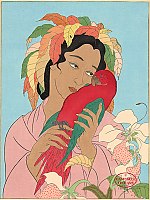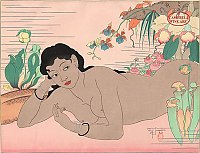 |
|
Paul Jacoulet1902 - 1960 |
|
|
Click on a picture for more details |
|
|
Paul Jacoulet’s family moved from their native France to Japan when Paul was around four years old. An only child, he was brought up in Tokyo. He showed an early love for the calligraphic art of Japan and even as a child began to study the Japanese prints of Utamaro. Although behind Charles Bartlett and Elizabeth Keith in entering the world of ukiyo-e printmaking, his grounding in Japanese culture was far deeper than these British artists. Paul Jacoulet showed exceptional artistic talent even as an adolescent but was a sickly youth, plagued by permanent health problems. Regarded as a beautiful young man, he took to wearing Japanese make-up and surrounded himself with dandies. His father had died in 1920 and his mother remarried after his father’s death, moving to Seoul in Korea. The 1923 earthquake formed a turning point in Paul Jacoulet’s life and from this date he began a more adventurous, personal style in his art. After befriending a young boy from the island of Truk in 1929, Paul Jacoulet spent the next eight winters in the South Pacific. He became captivated by the exotic islands of Truk, the Carolines, and others. For most of his life Paul Jacoulet was his own publisher, selling his prints not through shops, but by subscription. In order to expand his list of subscribers Paul Jacoulet formed the “Rainbow Club”, a club made up as much of young men who liked to drink and amuse themselves as lovers of art. His allowance from his mother stopped in 1938 and she died in 1940. Paul Jacoulet continued to sell prints during the early war years, though his foreign clientèle were melting away. The war drove him from Tokyo to the mountain resort of Karuizawa where he adopted a child and lived for the rest of his life. During the war he was under constant surveillance from the Japanese police, who regarded him as one of the strangest of all foreigners. After the American occupation when the war was over, Paul Jacoulet’s art became all the rage and by 1946 the foreign press were heralding his shows. Such was his success that in the early 1950’s he abandoned painting to devote himself exclusively to the creation of prints, but his continuing ill health began to take its toll and by the later 50’s his subscribers list had shrunk to less than fifty names. A great self-admirer, Paul Jacoulet often dressed in a kimono, wearing rice powder to ghostly effect and in his later years he became hugely over-indulgent. Due to his personal eccentricities he was refused a visa to enter the United States on his final world trip. He died in 1960 from diabetes. [more] |




